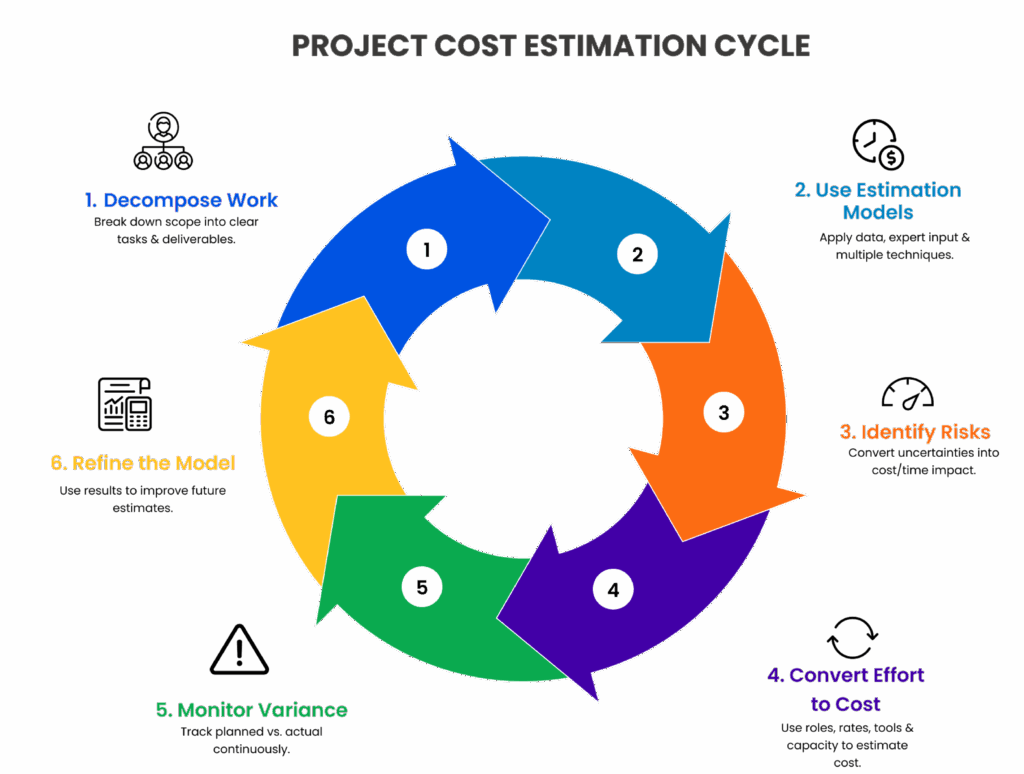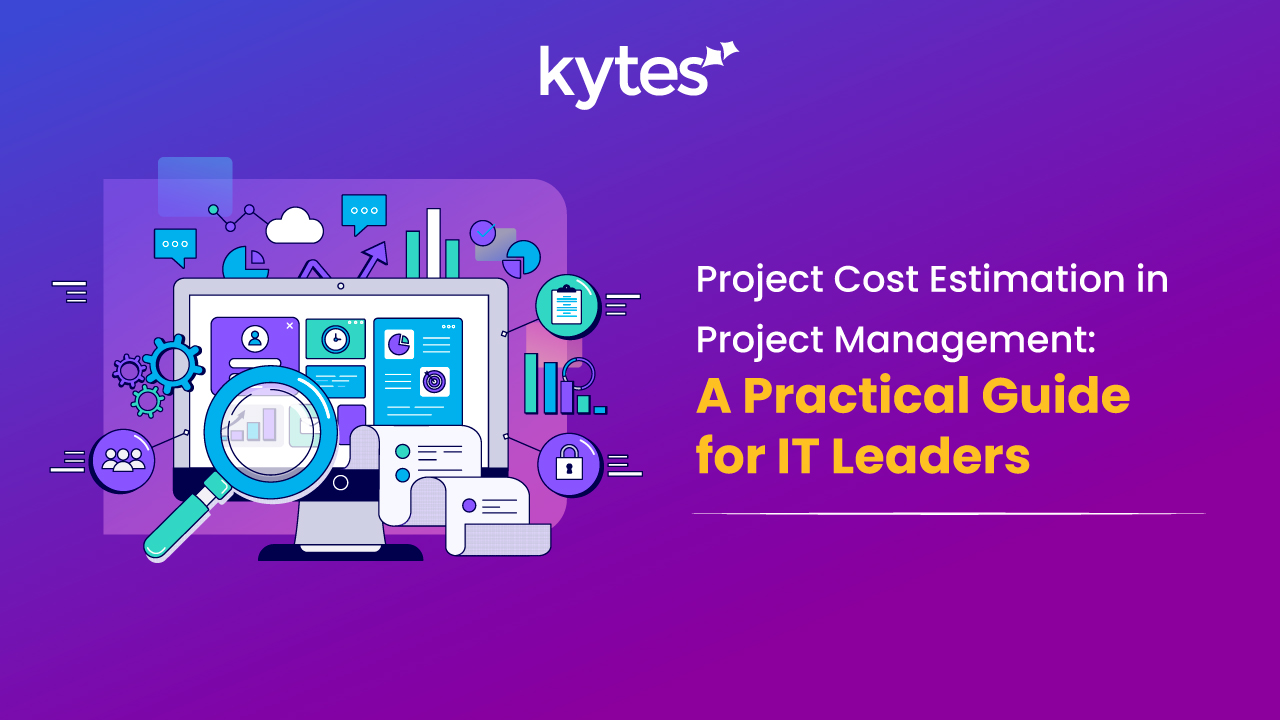Blog Highlights
- Practical insight into how to do cost estimation in project management for modern IT teams.
- Cost components explained clearly, helping define what a cost estimate is in project management.
- Guidance on how to estimate cost in project management using data, models, and continuous tracking.
- AI-enabled PSA + PPM intelligence that strengthens cost accuracy, forecasting, and control.
Software projects collapse when effort, manpower, and budget were estimated with too much optimism and too little data. Every CIO, delivery head, and PMO leader has lived through a sprint that stretched longer than planned, a feature that absorbed more engineering hours than expected, or a deployment that pushed the budget into difficult conversations. Cost estimation is rarely a spreadsheet exercise. It is a discipline that decides whether a project stays credible in the boardroom, or becomes another difficult post-mortem of what could have been.
This guide takes a practical look at project cost estimation in project management, particularly in IT environments where volatility, scope evolution, and talent constraints are natural constants. Instead of a theoretical explanation, the focus is on how modern delivery leaders can structure cost estimation in a way that is defensible, transparent, and continuously improvable.
Understanding What a Cost Estimate Really Represents
Before debating methods, it helps to define what is being estimated.
Many teams believe cost estimation is simply forecasting the money required to complete work. In reality, a cost estimate in project management is a structured prediction of every resource the project will consume. This includes roles, time, environments, licenses, vendor costs, training effort, contingency buffers, quality assurance cycles, infrastructure, and change management.
A good estimate does not aim for perfect accuracy on day one. It aims for controlled deviation. IT leaders who view estimation as an ongoing calibration exercise produce better outcomes than teams who treat it as a one-time planning cycle.
Why IT Projects Require a More Rigorous Cost Estimation Approach
Unlike construction or manufacturing, software work is rarely linear. A change in one function can impact five others. New requirements emerge after user feedback. Market conditions shift. Integration complexity increases when third-party systems behave unexpectedly.
Three characteristics make cost estimation harder in technology projects:
- Human effort is the highest cost component and developer productivity varies widely.
- Scope is dynamic, often evolving as product understanding matures.
- Work complexity increases invisibly, making late effort spikes common.
Because of this, estimation must combine structured financial discipline with real-time operational intelligence. Static upfront guesses are not enough. Ongoing measurement and refinement are mandatory.
The Core Components of Project Cost Estimation in Project Management
A strong cost estimate covers the following buckets:
- Human Resource Costs
Billable vs non-billable effort, blended rates, cross-team allocation, SME involvement, and leadership oversight. - Software and Infrastructure Costs
Hosting, compute usage, enterprise tools, version control, continuous integration systems, licenses, audit tools, and environment provisioning. - Third-Party and Vendor Contributions
APIs, specialized consultants, integrations, support plans, and transaction-based pricing. - Quality Assurance and Testing
Functional, security, performance, penetration testing, and regression cycles. - Risk and Contingency Buffers
This should not be a blind percentage; buffers must be tied to assessed risk areas. - Change Management and Training
UAT, documentation, enablement sessions, and post-launch stabilization.
When leaders evaluate these cost areas holistically instead of treating estimation as a basic headcount × time calculation, accuracy increases substantially.
How to Estimate Cost in Project Management – A Practical Framework
There is no single “right” model. However, the following step-by-step approach works consistently in the IT sector because it combines structure with adaptability.
1. Break Work into Estimable Units
Modules, features, tasks, and sprints should be scoped with clear acceptance criteria.
Vague requirements are the biggest cause of blown budgets.
2. Use Multiple Estimation Models in Combination
Relying on one method increases the chance of blind spots. Common approaches include:
- Analogous estimation: Uses historical projects as a reference.
- Parametric estimation: Applies defined formulas such as cost per function point.
- Expert judgment: Includes input from technical leads closest to the work.
- Bottom-up estimation: Rolls up estimates from task level to project level.
- Three-point estimation: Considers optimistic, pessimistic, and most likely scenarios.
Mature PMOs cross-verify two or more methods before finalizing projections.
3. Quantify Uncertainty Instead of Ignoring It
Uncertainty is not a reason to “pad” numbers. It should be identified, prioritized, and tied to measurable risks such as:
- Dependency instability
- Unfamiliar technology
- Unclear stakeholder expectations
- Environmental constraints
Budgets that show where risk resides also show how well the project is being governed.
4. Convert Effort Into Cost Transparently
Effort alone means little without:
- Hourly or role-based cost rates
- Overhead calculation
- External cost mapping
- Realistic percentage of usable hours per month
Teams that assume 100 percent utilization inevitably underestimate.
5. Track Accuracy Through the Lifecycle
Estimation is a loop, not an event.
Continuous feedback improves the system, the team, and future forecast quality.

This simple loop, when supported with consistent data, builds predictability into software delivery.
Advanced Practices for IT Leaders Who Want Better Accuracy
IT organizations with strong delivery maturity adopt a few advanced patterns:
They build estimation models from their own data instead of generic spreadsheets.
Historical velocity, overruns, and team composition become active inputs.
They measure planning accuracy publicly within the delivery organization.
When accuracy becomes a quality metric, performance naturally improves.
They adopt tooling that automates visibility, instead of relying on fragmented status updates.
Modern PSA and PPM platforms remove guesswork from time, allocation, and cost tracking.
They make assumptions explicit.
When every cost component has a justification, stakeholders understand trade-offs instead of challenging the numbers.
These behaviors shift estimation from prediction to disciplined management.
The Result of Mature Cost Estimation
Organizations that implement structured cost estimation practices see clear improvements:
- Fewer project escalations
- Predictable revenue recognition
- Better client trust
- Higher delivery confidence
- Improved utilization and forecasting accuracy
- Reduced budget slippage due to late surprises
The goal is not “perfect estimates.” It is credible estimates backed by continuous learning.
Final Thoughts
Cost estimation is one of the most important operational muscles in IT project management. It cannot be treated as a one-time budgeting checkpoint or as an optimistic best-case projection. The strongest delivery organizations treat estimation as a living system that improves with every sprint, every post-deployment analysis, and every completed project. When cost estimation becomes structured, transparent, and data-driven, project delivery becomes easier, revenue becomes predictable, and IT leadership operates with greater control.
About Kytes
Kytes is an AI-enabled PSA + PPM software purpose-built for IT/ITES companies that want delivery visibility without operational friction. It unifies project planning, time tracking, billing, cost control, and resource management into one system, helping teams estimate accurately, execute confidently, and scale profitably. Book a demo to see how.





